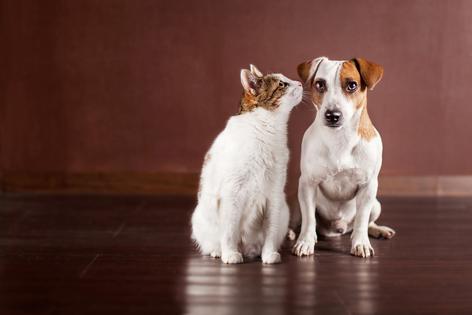My Pet World: Reader is worried about introducing emotional support dog to other pets
Dear Cathy,
My daughter requires an emotional support dog for anxiety. Her previous mixed-breed dog died three and a half years ago, and she is still grieving. We already have two three-year-old male cats (brothers). The cats are indoors and can access most of our big ten-room house.
What can we do to help these animals eventually accept one another? Would a smaller, say 30-pound, dog be a better pairing than a larger dog? Is one dog breed more likely to be less aggressive and more accepting of our cats? I realize that so much depends upon the dog's disposition and personality. Thank you for any advice.
– Laura, Amityville, New York
Dear Laura,
I'm sorry to hear about your daughter's loss. The pain of losing a beloved pet is something that can remain with us for a lifetime.
Introducing a new dog into a household with cats can be challenging, but it can be done successfully with careful planning and patience.
Here are some steps to take during those early introductions:
First, choose the right dog. Every dog and cat is an individual, and their ability to get along with other dogs or cats depends on their unique personalities and early exposure to other pets, much more than breed.
Big dogs can be friendly with cats, but a smaller dog might be less intimidating to your cats. In general, look for a dog with a calm and gentle disposition, either a puppy who can be raised around the cats or an adult dog whose temperament with cats has already been assessed by a shelter or rescue organization.
Gradually introduce them. Start by keeping them in separate areas of the house, allowing them to sniff each other's belongings (scent swapping) to get used to each other's scent. You can use baby gates or a kennel (for the dog) initially to allow them to see each other without direct contact.
When it's time for face-to-face meetings, keep the dog on a leash and allow the cats to approach at their own pace. Do not take the dog over to meet the cat. If you have any concerns about the dog’s initial reactions, place a basket muzzle on him for the first few meet and greets. Reward both the dog and the cats with treats and praise for calm behavior. Keep these sessions short and positive.
Be mindful that the introduction of a new dog disrupts the cats' established territory, so it's important to provide them with plenty of safe spaces, like tunnels, baskets, boxes, and cave-like beds, and high places, like tall scratching posts, where the cat can remain in the room but out of reach of the dog.
Sadly, cats often get less attention when a new dog is added to the home, and they may go into hiding if they are scared. Because they are not around, the pet parent assumes all is going well. But the cat is hiding because he is scared. Provide them with feline pheromone collars to help them relax during the dog's first few weeks in the home, address their needs, and give them lots of extra love and attention.
Positive reinforcement training can be very effective. Teach the new dog basic commands like "sit," "stay," and "leave it" right away to manage his or her behavior around the cats. Even when they seem alright hanging out together, continue to supervise their interactions for the next several weeks or months to ensure a solid foundation of respect builds between them.
Most importantly, be patient and go at the pace of your pets. Forcing interactions can lead to stress and aggression. Good luck with your new addition, and I hope your daughter finds comfort and support with her new emotional support dog. Dogs and cats can coexist peacefully with time, patience, and the right approach.
Dear Cathy,
I read your column in the Wisconsin State Journal regarding the early-rising hungry cat. We just solved that very problem by getting an automatic feeder. It has two compartments that can be set to different times. We put a little snack in each and set them for various times during the night. Now, we sleep uninterrupted. It was very inexpensive. There is no need to visit the vet or a cat psychologist.
– Lance, Madison, Wisconsin
Dear Lance,
Thank you for sharing your tip. An automatic feeder is a great idea and can indeed solve the problem of early morning wake-up calls from a hungry cat. It's wonderful to hear that it has allowed you to sleep uninterrupted. Your practical approach highlights how simple solutions can sometimes be the most effective.
_____
_____
========
(Cathy M. Rosenthal is a longtime animal advocate, author, columnist and pet expert who has more than 25 years in the animal welfare field. Send your pet questions, stories and tips to cathy@petpundit.com. Please include your name, city, and state. You can follow her @cathymrosenthal.)
©2024 Tribune Content Agency, LLC.
(c) 2024 DISTRIBUTED BY TRIBUNE MEDIA SERVICES, INC.












Comments